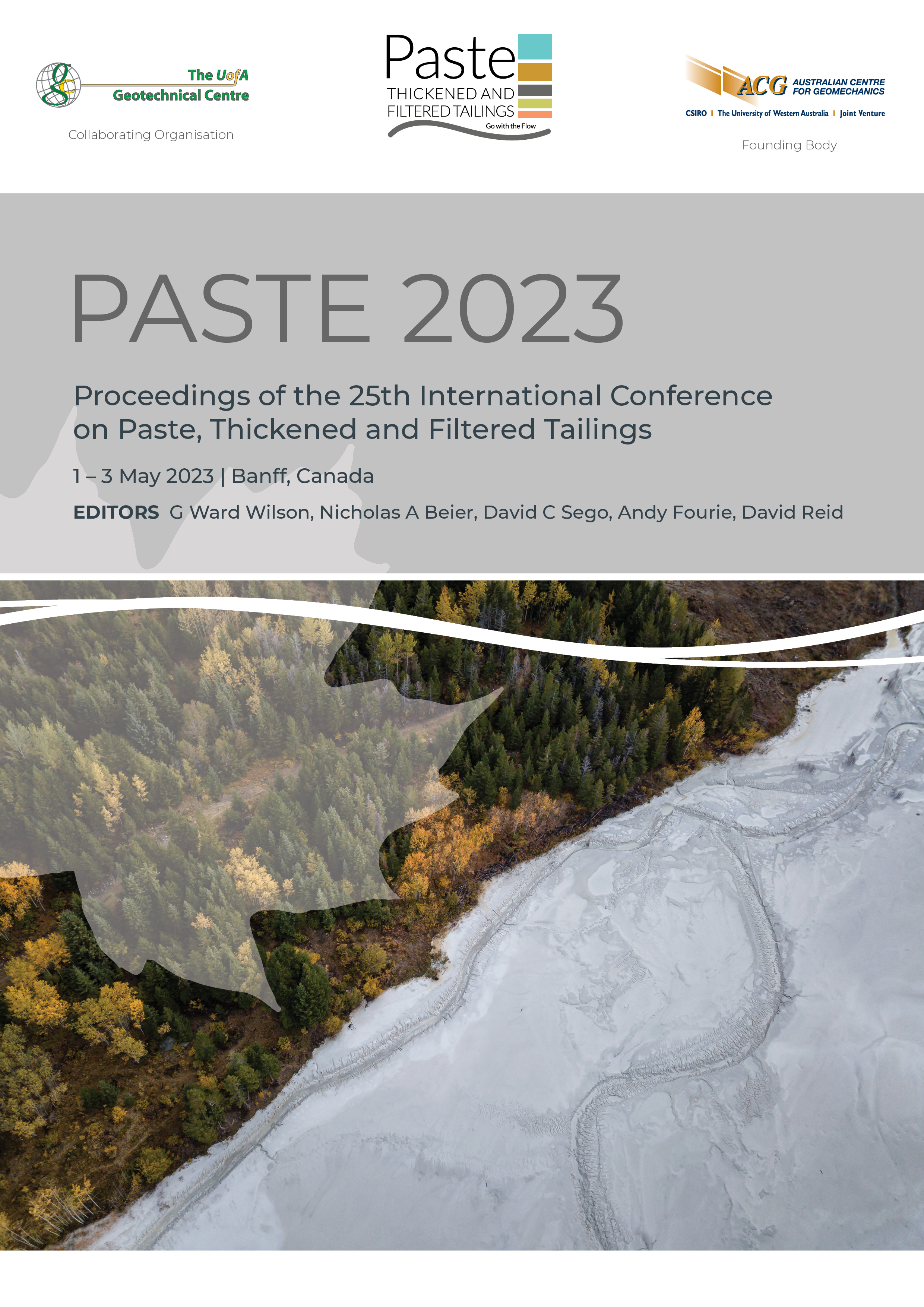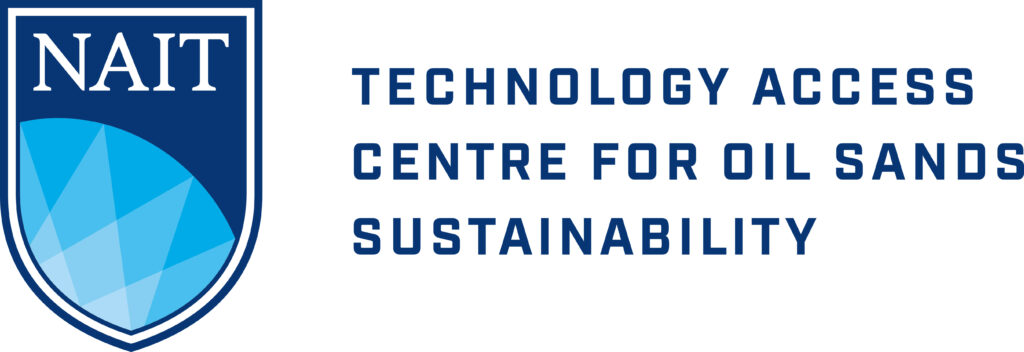Determination of the relationship between direct tensile test and Brazilian splitting test of cemented tailings backfill

|
Authors: Tang, G; Guo, L; Liu, G; Yang, X |
DOI https://doi.org/10.36487/ACG_repo/2355_07
Cite As:
Tang, G, Guo, L, Liu, G & Yang, X 2023, 'Determination of the relationship between direct tensile test and Brazilian splitting test of cemented tailings backfill', in GW Wilson, NA Beier, DC Sego, AB Fourie & D Reid (eds), Paste 2023: Proceedings of the 25th International Conference on Paste, Thickened and Filtered Tailings, Australian Centre for Geomechanics, Perth, pp. 98-111, https://doi.org/10.36487/ACG_repo/2355_07
Abstract:
Cemented tailings backfill (CTB) is an artificial structure that provides ground support for the mining structure in the cut-and-fill mining method. The stability of CTB has a bearing on safe and economical production in mines. Tensile strength is an important design parameter that affects the quality of CTB. The Brazilian splitting test (BT) operation is more convenient but the accuracy of results is insufficient. The direct tensile test (DTT), the results of which are accurate though the test threshold is high, can be used to determine the tensile strength of CTB. Therefore, by determining the differences between the results of the two test methods, the tensile strength of CTB can be obtained more precisely using BT. In this study, DTT and BT were performed on CTB with various solid mass contents, binder contents and curing times. The findings demonstrated that, with only numerical differences, the tensile strength of CTB obtained from DTT and BT follows the same pattern of variation with binder content, solid mass content and curing period. The results of BT were lower than those of DTT because the Poisson effect reduces the tensile strength of the BT specimens. A linear fit between the DTT and BT results showed a strong linear correlation with a scale factor of 2.435. This study obtained the scale relationship between the DTT and BT results for the CTB at the test level. The study’s findings can serve as a guide for improving the quality assessments and strength designs of CTB in mines.
Keywords: cemented tailings backfill, tensile strength, direct tensile test, Brazilian splitting test
References:
Akazawa, T 1943, ‘New test method for evaluating internal stress due to compression of concrete (the splitting tension test)(part 1)’, Journal of Japan Society of Civil Engineers, vol. 29, pp. 777–787.
ASTM International 2016, Standard Test Method for Splitting Tensile Strength of Intact Rock Core Specimens (ASTM 2016 D 3967:2016), ASTM International, West Conshohocken.
Barla, G & Innaurato, N 1973, ‘Indirect tensile testing of anisotropic rocks’, Rock Mechanics, vol. 5, no. 4, pp. 215–230.
Belem, T & Benzaazoua, M 2004, ‘An overview on the use of paste backfill technology as a ground support method in cut-and-fill mines’, in E Villaescusa & Y Potvin (eds), Proceedings of the 5th International Symposium on Ground Support in Mining and Underground Construction, A.A. Balkema, Rotterdam, pp. 28–30.
Belem, T & Benzaazoua, M 2008, ‘Design and application of underground mine paste backfill technology’, Geotechnical and Geological Engineering, vol. 26, no. 2, pp. 147–174.
Belem, T, Benzaazoua, M, & Bussière, B 2000, ‘Mechanical behaviour of cemented paste backfill’, Proceedings of the 53rd Canadian Geotechnical Conference, pp. 373–380.
Bieniawski, Z, & Hawkes, I 1978, ‘Suggested methods for determining tensile strength of rock materials’, International Journal of Rock Mechanics and Mining Sciences & Geomechanics Abstracts, vol. 15, no. 3, pp. 99–103.
Bull, AJ & Fall, M 2020, ‘Curing temperature dependency of the release of arsenic from cemented paste backfill made with Portland cement’, Journal of Environmental Management, vol. 269,
Butenuth, C, Freitas, MD, Al-Samahiji D, Park, H, Cosgrove, J & Schetelig, K 1993, ‘Observations on the measurement of tensile strength using the hoop test’, International Journal of Rock Mechanics and Mining Sciences & Geomechanics Abstracts, vol. 30, no. 2, pp. 157–162.
Caceres, C, Moffat, R, & Pakalnis, R 2017, ‘Evaluation of flexural failure of sill mats using classical beam theory and numerical models’, International Journal of Rock Mechanics and Mining Sciences, vol. 99, pp. 21–27.
Cao, S, Xue, G, Song, W & Teng, Q 2020, ‘Strain rate effect on dynamic mechanical properties and microstructure of cemented tailings composites’, Construction and Building Materials, vol. 247.
Carneiro, FLLB 1943, ‘A new method to determine the tensile strength of concrete’, Proceedings of the 5th meeting of the Brazilian Association for Technical Rules, vol. 3, no. 16, pp. 126–129.
Chen, X, Shi, X, Zhou, J & Yu, Z 2019, ‘Influence of polypropylene fiber reinforcement on tensile behavior and failure mode of tailings cemented paste backfill’, IEEE Access, vol. 7, pp. 69015–69026.
Coviello, A, Lagioia, R & Nova, R 2005, ‘On the measurement of the tensile strength of soft rocks’, Rock Mechanics and Rock Engineering, vol. 38, no. 38, pp. 251–273.
Deng, HF, Li, JL, Zhu, M, Wang, RH, Yuan, X, F, & Liu, Q 2012. ‘Research on effect of disc thickness-to-diameter ratio on splitting tensile strength of rock’. Chinese Journal of Rock Mechanics and Engineering, vol. 31, no. 4, pp.792-798.
Deng, X, Zhang, J, Klein, B, Zhou, N & Dewit, B 2017, ‘Experimental characterization of the influence of solid components on the rheological and mechanical properties of cemented paste backfill’, International Journal of Mineral Processing, vol. 168, pp. 116-125.
Fahimifar, A & Malekpour, M 2012, ‘Experimental and numerical analysis of indirect and direct tensile strength using fracture mechanics concepts’, Bulletin of Engineering Geology and the Environment, vol. 71, no. 2, pp. 269-283.
Fairhurst, C 1964, ‘On the validity of the ‘Brazilian’ test for brittle materials’, International Journal of Rock Mechanics and Mining Sciences & Geomechanics Abstracts, vol. 1, no. 4, pp. 535–546.
Fall, M, Belem, T, Samb, S & Benzaazoua, M 2007, ‘Experimental characterization of the stress–strain behaviour of cemented paste backfill in compression’, Journal of Materials Science, vol. 42, no. 11, pp. 3914–3922.
Guo, LJ, Peng, XP, Zhao, Y, Liu, GS, Tang, GX & Pan, A 2022, ‘Experimental study on direct tensile properties of cemented paste backfill’, Frontiers in Materials, vol. 9,
Hoek, E 1964, ‘Fracture of anisotropic rock’, Journal of the Southern African Institute of Mining and Metallurgy, vol. 64, no. 10, pp. 501–518.
Hondros, G 1959, ‘The evaluation of Poisson's ratio and the modulus of materials of low tensile resistance by the Brazilian (indirect tensile) test with particular reference to concrete’, Australian Journal of Basic and Applied Sciences, vol. 10, no. 3,
pp. 243–268.
Hudson, JA 1969, ‘Tensile strength and the ring test’, International Journal of Rock Mechanics and Mining Sciences & Geomechanics Abstracts, vol. 6, no. 1, pp. 91–97.
Jaeger, JC & Hoskins, ER 1966, ‘Rock failure under the confined Brazilian test’, Journal of Geophysical Research, vol. 71, no. 10, pp. 2651–2659.
Jahanbakhshzadeh, A, Aubertin, M & Li, L 2017, ‘A new analytical solution for the stress state in inclined backfilled mine stopes’, Geotechnical and Geological Engineering, vol. 120, no. 3, pp. 1151–1167.
Kesimal, A, Yilmaz, E, Ercikdi, B, Alp, I & Deveci, H 2005, ‘Effect of properties of tailings and binder on the short-and long-term strength and stability of cemented paste backfill’, Materials Letters, vol. 59, no. 28, pp. 3703–3709.
Klanphumeesri, S 2002, ‘Direct tension testing of rock specimens’, master’s thesis, Suranaree University of Technology, Suranaree.
Komurlu, E, Kesimal, A & Demir, S 2016, ‘Experimental and numerical analyses on determination of indirect (splitting) tensile strength of cemented paste backfill materials under different loading apparatus’, Geomechanics and Engineering, vol. 10, no. 6, pp. 775–791.
Liu, G, Li, L, Yao, M, Landry, D, Malek, F, Yang, X & Guo, L 2017, ‘An investigation of the uniaxial compressive strength of a cemented hydraulic backfill made of alluvial sand’, Minerals, vol. 7, no. 1, p. 4.
Mellor, M & Hawkes, I 1971, ‘Measurement of tensile strength by diametral compression of discs and annuli’, Engineering Geology, vol. 5, no. 3, pp. 173–225.
Mitchell, RJ, Olsen, RS, & Smith, JD 1982, ‘Model studies on cemented tailings used in mine backfill’, Canadian Geotechnical Journal, vol. 19, no. 1, pp. 14–28.
Nasir, O & Fall, M 2008, ‘Shear behaviour of cemented pastefill-rock interfaces’, Engineering Geology, vol. 101, no. 3–4, pp. 146–153.
Pan, A & Grabinsky, MW 2021, ‘Tensile strength of cemented paste backfill’, Geotechnical Testing Journal, vol. 44, no. 6,
pp. 1886–1897.
Qiao, L, Li, Q & Zhao, G 2022, ‘Numerical study of the Brazilian tensile test: 2D and 3D simulations’, Chinese Journal of Engineering, vol. 44, no. 1, pp. 131–142.
Simon, D & Grabinsky, MW 2012, ‘Electromagnetic wave-based measurement techniques to study the role of Portland cement hydration in cemented paste backfill materials’, International Journal of Mining, Reclamation and Environment, vol. 26, no. 3, pp. 3–28.
Sivakugan, N, Rankine, RM, Rankine, KJ & Rankine, KS 2006, ‘Geotechnical considerations in mine backfilling in Australia’, Journal of Cleaner Production, vol. 14, no. 12–13, pp. 1168–1175.
Sundaram, PN & Corrales, JM 1980, ‘Brazilian tensile strength of rocks with different elastic properties in tension and compression’, International Journal of Rock Mechanics and Mining Sciences & Geomechanics Abstracts, vol. 17, no. 2, pp. 131–133.
Tamrakar, SB, Toyosawa, Y & Itoh, K 2005, ‘Tensile strength of soil measured using newly developed tensile strength apparatus’, Research Reports of National Institute of Industrial Safety, vol. 2004, pp. 41–51.
Van Mier, JGM & Van Vliet, MRA 2002, ‘Uniaxial tension test for the determination of fracture parameters of concrete: state of the art’, Engineering Fracture Mechanics, vol. 69, no. 2, pp. 235–247.
Yilmaz, E, Benzaazoua, M, Belem, T & Bussière, B 2009, ‘Effect of curing under pressure on compressive strength development of cemented paste backfill’, Minerals Engineering, vol. 22, no. 9–10, pp. 772–785.
Yılmaz, T, Ercikdi, B, Karaman, K & Külekçi, G 2014, ‘Assessment of strength properties of cemented paste backfill by ultrasonic pulse velocity test’, Ultrasonics, vol. 54, no. 5, pp. 1386–1394.
Yu, B 2001, ‘Analysis of factors to affect the strength of cemented tailings grain fillings’, Heibei Metallugry, vol. 3, pp. 3–6.
Yu, Y 2005, ‘Questioning the validity of the Brazilian test for determining tensile strength of rocks’, Yanshilixue Yu Gongcheng Xuebao/Chinese Journal of Rock Mechanics and Engineering, vol. 24, no. 7, pp. 1150–1157.
Yu, Y, Yin, J & Zhong, Z 2006, ‘Shape effects in the Brazilian tensile strength test and a 3D FEM correction’, International journal of rock mechanics and mining sciences, vol. 43, no. 4, pp. 623–627.
Yu, Y, Zhang, J & Zhang, J 2009, ‘A modified Brazilian disk tension test’, International journal of rock mechanics and mining sciences, vol. 46, no. 2, pp. 421–425.
Zhang, S 1979, ‘Theoretical relationship and test comparison between splitting tensile strength and axial tensile strength of concrete’, Journal of Changsha Railway University, vol. 2, pp. 65–82+199.
Zhao, Y, Taheri, A, Karakus, M, Chen, Z & Deng, A 2020, ‘Effects of water content, water type and temperature on the rheological behaviour of slag-cement and fly ash-cement paste backfill’, International Journal of Mining Science and Technology, vol. 30, no. 3, pp. 271–278.
Zhou, Y, Yan, Y, Zhao, K, Yu, X, Song, Y, Wang, J & Suo, T 2021, ‘Study of the effect of loading modes on the acoustic emission fractal and damage characteristics of cemented paste backfill’, Construction and Building Materials, vol. 277,
© Copyright 2025, Australian Centre for Geomechanics (ACG), The University of Western Australia. All rights reserved.
View copyright/legal information
Please direct any queries or error reports to repository-acg@uwa.edu.au
View copyright/legal information
Please direct any queries or error reports to repository-acg@uwa.edu.au



